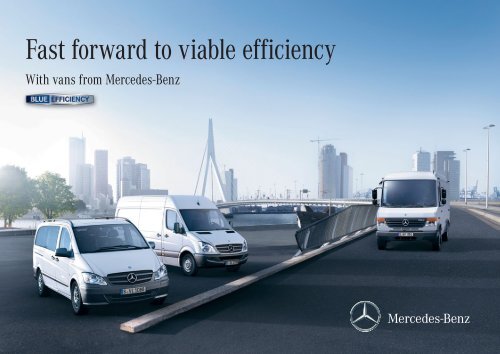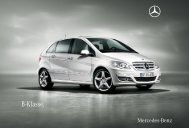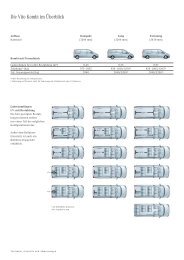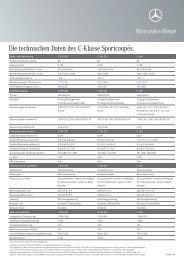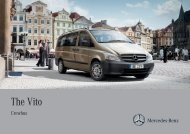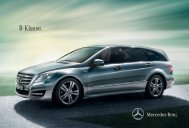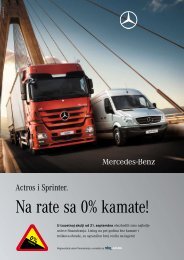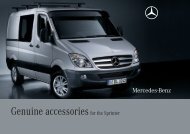Download BlueEFFICIENCY brochure
Download BlueEFFICIENCY brochure
Download BlueEFFICIENCY brochure
- No tags were found...
You also want an ePaper? Increase the reach of your titles
YUMPU automatically turns print PDFs into web optimized ePapers that Google loves.
Fast forward to viable efficiencyWith vans from Mercedes-Benz
Less fuel, more future: our vans with<strong>BlueEFFICIENCY</strong> technology<strong>BlueEFFICIENCY</strong> means cutting consumption, saving costs and easing the burden on the environment.Efficiency packagePage 6LGT(Liquefied Gas Technology)Page 10NGT(Natural Gas Technology)Page 8As the inventor of the car, Mercedes-Benz is committed toshaping the future of mobility in a responsible manner.At the same time we are constantly working on making theuse of vans ever more economical for our customers. The<strong>BlueEFFICIENCY</strong> technologies for vans from Mercedes-Benzprove that these aims go hand in hand.<strong>BlueEFFICIENCY</strong> is an umbrella term for a series of innovativetechnologies which facilitate a tangible reductionin consumption and emissions. Various <strong>BlueEFFICIENCY</strong>technologies are already available in our vans, playing theirpart to ease the burden on the environment and enhanceour van customers’ success in economic terms.Over and above this, our developers are working intensivelyon emission-free mobility. The stages along the road toachieving this involve the optimisation of the available internalcombustion engines as well as the further develop -ment of BlueTEC technology and of hybrid and electric drivesystems, which are already undergoing field tests.2
E-CELL(Electric drive system)Page 14HYBRIDPage 16BlueTEC(SCR diesel technology)Page 12We would like to give you a detailed insight into whatwe have to offer. The pages that follow provide an over -view of our efficient solutions for today and tomorrow.Further information is available from your authorisedMercedes-Benz dealer.
Rural transportLong distanceAreas of operation▸ Inter-urban operations and suburbs▸ Average speeds▸ Mainly one-day tours returning tothe point of origin▸ Annual mileage > 20,000 kmTypical sectors▸ Construction▸ Service▸ Commerce▸ The tradesVehicle configuration▸ Fuel-efficient, low-emission drive system▸ Optimised for rural routes<strong>BlueEFFICIENCY</strong> technologies▸ Efficiency package 1▸ NGT (natural gas drive)▸ LGT (liquefied gas drive)▸ BlueTEC▸ HYBRIDAreas of operation▸ Transport assignments onmotorways and highways▸ Higher speeds▸ Very long distances, few stops▸ Annual mileage > 80,000 kmTypical sectors▸ Express services▸ Courier services▸ Freight servicesVehicle configuration▸ Fuel-efficient, low-emission drive system▸ Optimised for long distances and higher speeds<strong>BlueEFFICIENCY</strong> technologies▸ Efficiency package 1▸ BlueTEC
The efficiency package.Or how to combine economy measures intelligentlyDepending on the vehicle model (Vito or Sprinter), the efficiency package 1 consistsof various different components that were specially developed for the vehicle modelin question and add up to a positive effect on fuel consumption.1The constituent parts of the efficiency package vary depending on the model6
Count on efficiencyEngine, transmission, ancillary assemblies – there are lots of factors which influencea van’s fuel consumption. Our engineers have scrutinised every singledetail in their search for opportunities to make the individual components andsystems more efficient. The result is a whole raft of innovative measures foroptimising fuel consumption and reducing emissions.The efficiency package1available for the Sprinter and Vito in various differentversions offers a series of intelligent solutions for everyday driving. First andforemost, the advanced OM 651 4-cylinder CDI diesel engine, which is availablewith a choice of power output ratings, as well as the OM 642 6-cylinder CDIdiesel engine ensure that both models are able to offer efficient consumption anda high degree of environmental compatibility. With its low emissions, the4-cylinder diesel engine meets the requirements of the Euro V/III / Euro Vemissions standard and, as an option in the Sprinter, for instance, can evenattain the very stringent European EEV (Enhanced Environmentally FriendlyVehicle) emissions standard. The ideal complement to the engines is theECO Gear manual transmission. In conjunction with the OM 651 and OM 642(Sprinter only) diesel engines, this unit cuts the combined consumption to alevel significantly lower than that achieved with previous CDI diesels.In addition to this, the ECO start/stop function 2 helps to save fuel whereverpossible. If the vehicle has been standing still for more than three seconds(Sprinter) or the brakes have been applied (Vito), the engine is automaticallyswitched off if no gear is engaged and the clutch pedal is not depressed.In city-centre driving with frequent stops at traffic signals, consumption canbe reduced by as much as 8% through this technology alone, comparedwith an identical vehicle without the ECO start/stop function.1Not in conjunction with petrol engine2Not in conjunction with automatic transmission3The efficiency package with automatic transmission and 4x2 drive for the Sprinter will not be available until the introductionof the new 7G-TRONIC 7-speed automatic transmission (expected to be available from first quarter of 2012)
<strong>BlueEFFICIENCY</strong> efficiency package for the Sprinter1, 3, 4With manual transmission▸ OM 651 diesel engine (Euro V or Euro 5 Gr. III)or OM 642 diesel engine (Euro V)▸ ECO Gear optimised manual transmission▸ ECO start/stop functionWith automatic transmission▸ OM 651 diesel engine (Euro V or Euro 5 Gr. III)or OM 642 diesel engine (Euro V)▸ ECO power-steering pump▸ Electrically controlled fuel pump▸ ECO power-steering pump ▸ Tyres with optimised rolling resistance5▸ Electrically controlled fuel pump▸ Shift point recommendation▸ Tyres with optimised rolling resistance5▸ Alternator management▸ Battery management▸ In-engine measures▸ Alternator management▸ Battery management▸ In-engine measures<strong>BlueEFFICIENCY</strong> efficiency package for the Vito 1, 6With manual transmission▸ OM 651 Euro 5 Gr. III diesel engine▸ ECO Gear optimised manual transmission▸ ECO start/stop function▸ ECO power-steering pump▸ Electrically controlled fuel pump▸ Shift point recommendation▸ Tyres with optimised rolling resistanceWith automatic transmission▸ OM 651 or OM 642 Euro 5 Gr. III diesel engine▸ ECO power-steering pump▸ Electrically controlled fuel pump▸ Tyres with optimised rolling resistance▸ Alternator management▸ Battery management▸ In-engine measures▸ Alternator management▸ Battery management▸ In-engine measures4Where the Sprinter is registered as a commercial vehicle, the shift point recommendation, battery management and in-engine measuresare standard; all other items are special equipment. Where the Sprinter is registered as a passenger car, the efficiency package is includedas standard5If available for the particular model variant, otherwise standard tyres6Where the Vito is registered as a commercialvehicle, the ECO Gear manual transmission, electrically controlled fuel pump, battery management and in-engine measures are standard;all other items are special equipment. Where the Vito is registered as a passenger car, the efficiency package is included as standard
NGT. The innovative Natural Gas TechnologyC ompared w ith other common f uels , natural gas possesses the highest energy densityand produces the lowest particulate emissions. The natural gas drive system makes useof these properties – and combines them with attractive economic benefits.8
Natural gas: a fuel that pays – and not justwhere the environment is concernedADDITIONAL GASCYLINDER(SPECIAL EQUIPMENT)FILLINGCONNECTION FORNATURAL GASFUEL TANKFILLINGCONNECTIONFOR PETROLINJECTION NOZZLESFOR FUELINTERNAL COMBUSTION ENGINEGAS CYLINDER(STANDARD SPECIFICATION)PRESSURE REGULATORINJECTION NOZZLESFOR NATURAL GASNatural Gas Technology (NGT) from Mercedes-Benz is a <strong>BlueEFFICIENCY</strong>technology with an extremely low pollutant output and a high cost-saving potential.In the bi-fuel variant of the Sprinter NGT 1 you can switch over from natural gasmode to petrol mode at the touch of a button – and vice versa. Thanks to this“twin-track approach”, the drive system is suitable both for use in conurbationsand for rural journeys.In the mono-fuel variant, the Sprinter NGT is regarded as being exclusively anatural gas vehicle.
The benefits of the mono-fuel Sprinter NGT become particularly apparent in urbanareas. The petrol carried in the reduced-size petrol tank (< 15 l) serves only tostart the engine and as an emergency reserve. Switch-over occurs automaticallyand cannot be influenced by the driver. The mono-fuel Sprinter NGT alreadymeets the stringent European emissions standard EEV (Enhanced EnvironmentallyFriendly Vehicle).When it comes to fuel costs, both NGT variants offer a major advantage: CNG(Compressed Natural Gas) is around 25% less expensive in Germany, for instance,than the equivalent amount of diesel fuel (as at April 2011). Furthermore, someEuropean countries have introduced tax concessions, incentives and other advantages,such as lower insurance premiums.The Sprinter NGT1▸ Bi-fuel natural gas/petrol drive system (M 271 4-cylinder natural gas/petrol engine)▸ Mono-fuel natural gas drive▸ Up to 20% lower CO 2 emissions than a petrol engine▸ Virtually no particulate emissions▸ Major savings possible where fuel costs are concerned▸ Bi-fuel mode has a long range of up to 1200 km, while natural gas mode alone allows a range of up to470 km (depending on the number and volume of pressurised gas tanks)▸ Underfloor installation of pressurised gas tanks means that no space is lost in the load compartment1Your authorised Mercedes-Benz dealer will be pleased to tell you which Sprinter variants can be specified with the NGT natural gasdrive system
Kind to your bank balance, kind to the environment:the liquefied gas drive system LGTWith the <strong>BlueEFFICIENCY</strong> technology LGT you are deciding in favour of economy andecology in equal measure. And you remain flexible at all times, thanks to the bi-fuelconfiguration and the already extensive network of LPG filling stations.10
Ideally equipped for the future:LGT (Liquefied Gas Technology)LPG TANK(LIQUEFIED GAS TANK)FILLING CONNECTIONFOR LPGFILLINGCONNECTIONFOR PETROLINJECTION NOZZLESFOR FUELINTERNAL COMBUSTION ENGINEFUEL TANKPRESSUREREGULATORINJECTION NOZZLESFOR LPGLiquefied gas has long since made a name for itself when it comes to heatingand cooking, and now the mixture of propane and butane is triumphing on theroad, too – for good reason. Because firstly, liquefied gas (Liquefied PetroleumGas, LPG for short) boasts a significantly better LCA than petrol during combustionin a petrol engine: around 10% less CO 2 and much lower carbon monoxide,hydrocarbon and NO X emissions than petrol engines are strong arguments in itsfavour. And secondly, refuelling bills are lower than those for petrol or dieselfuel – in some countries there are even major savings to be made due to taxconcessions.
With the Sprinter LGT 1 you can benefit from all of these advantages – and fromothers besides. Because the bi-fuel configuration of the LGT drive system makesit possible for you to choose between liquefied gas and petrol mode as required.After a short warm-up phase in petrol mode you can change the operating modeat any time by pressing a button. This means that you can increase the radiusof operation – up to 450 km in purely liquefied gas mode – and the supply securitywithout any problems whatsoever.The Sprinter LGT 1▸ Bi-fuel liquefied gas/petrol drive system (M 271 4-cylinder liquefied gas/petrol engine)▸ Up to 10% lower CO 2 emissions than conventional petrol engines▸ Lower pollutant emissions, virtually no particulate emissions▸ Major savings possible where fuel costs are concerned▸ Range in LPG mode up to approx. 450 km▸ Large network of filling stations▸ Underfloor installation of liquefied gas tanks means that no space is lost in the load compartment▸ Only slight reduction in payload1Your authorised Mercedes-Benz dealer will be pleased to tell you which Sprinter variants can be specified with the LGT liquefied gasdrive system
Clean and efficient: BlueTECBlueTEC is the trend-setting SCR diesel technology from Mercedes-Benz.In the Vario it ensures that the requirements of the EURO V emissions standardare convincingly met – economically and ecologically.12
BlueTEC. Lower emissionsthanks to innovative emission controlINTERNAL COMBUSTION ENGINESCR CATALYTIC CONVERTERADBLUEINJECTIONADBLUE TANKAs variable as an MPV, as robust as a light truck: the Vario is the classic modelin the Mercedes-Benz van range. A classic model that is also cutting-edge whenit comes to the crucial matters of fuel consumption and emissions – thanks tothe <strong>BlueEFFICIENCY</strong> technology BlueTEC. With it the Vario meets the requirementsof the EURO V emissions standard, while benefiting from an engine optimisedwith regard to performance characteristics and fuel consumption.This technology has been successfully established in Mercedes-Benz trucks since2005. And now the Vario is also able to benefit from SCR (Selective CatalyticReduction) exhaust gas aftertreatment which reduces NO X emissions from thehigh-displacement diesel engines by feeding the exhaust gases through acatalytic converter, where they are mixed with the water-based additive AdBlue .During this process, nitrogen oxides are turned into nitrogen and water.The result is compliance with the stringent EURO V emissions standard.
Incidentally, in everyday use the only indication that you have BlueTEC, one ofthe most advanced exhaust gas technologies, on board is the separate fillingneck for the AdBlue additive. It is situated in the direct vicinity of the fuel fillingneck. This means that replenishing the SCR tank with AdBlue additive doesnot take up any extra time as this task can be carried out at the same time as thefuel tank is being filled with diesel. The 18-litre volume of the additive tankensures that AdBlue only has to be replenished about every third time the fueltank is filled up with diesel.The Vario BlueTEC▸ Cutting-edge SCR diesel technology▸ Compliance with the stringent Euro V emissions standard
Facing the future with zero local emissions –the E-CELL electric drive systemThanks to the Vito E-CELL the dream of emission-free driving is coming evercloser to reality: it is the first van from Mercedes-Benz to be driven purelyelectrically.14
E-CELL: “electrifying” perspectivesfor urban trafficLITHIUM-ION BATTERYPLUG-INELECTRIC MOTORAND RECUPERATIONCONTROL ELECTRONICSIn commercial goods transport, too, the electric drive system is deemed to bethe key to environmentally aware and individual mobility of the future. Batterydrivenvans offer a very promising solution – above all when it comes to urbantraffic and short-radius distribution transport: they produce neither carbon dioxidenor pollutant emissions and have significantly lower noise emissions thanvehicles with a conventional drive system. As they are emission-free locally – i.e.they emit no pollutants whatsoever at the location where they are used – thereare many situations in which electric-driven vans can also be used where conventionallydriven vehicles are denied access: in city centres with entry restrictions,in environmentally sensitive areas such as pedestrian zones, in healthresorts and parks or in closed exhibition halls.
With the Vito E-CELL, Mercedes-Benz is heralding a new era of electric mobility.Its drive concept is designed purely for electric operation and represents acomplete departure from the drive train designed for internal combustion engines.With these characteristics it is aimed at commercial customers who mainlyuse their vans in urban areas and for short distances. First and foremost theseinclude fleet operators, public institutions, delivery companies and courier,express and parcel services. 2011 sees the start of series production and deliveryin 7 countries: Germany, Spain, France, Great Britain, Netherlands, Swedenand Denmark.T he Vito E - CEL L▸ Electric drive system for locally emission-free driving▸ High-performance lithium-ion battery▸ Electric motor with 60-kW output, top speed 80 km/h▸ On the basis of the European NEDC (New European Driving Cycle) directive, the range is up to 130 km▸ Heavy-current charging at 400 V takes about 5 hours for a fully discharged battery. As an alternative,a conventional 230 V power outlet 1 can be used; this doubles the charging time▸ Major savings where operating costs are concerned compared with drive systems with an internalcombustion engine, tax exemption in many European countries▸ No access restrictions, free entry to cities with a congestion charge▸ Safety features and cargo volume are not compromised1Optional 230-volt charging cable due to be available from 1 st quarter, 2012
And tomorrow?Internal combustion engine meets electric motor – the hybrid drivesystem unites the advantages enjoyed by both drive systems in asingle vehicle. Van customers who value flexibility when it comes to thefield of application will benefit in particular from this combination inthe future.16
HYBRID. On the road to perfect interplay between the internalcombustion engine and the electric drive systemINTERNAL COMBUSTION ENGINEAUTOMATICTRANSMISSIONHIGH-VOLTAGE BATTERYELECTRIC MOTORCONTROL/POWER ELECTRONICSWhen there is a need for a long operating range, the most practical solution isprovided by optimised internal combustion engines – engines such as thoseoffered by Mercedes-Benz as part of the efficiency package. The electric drivesystem E-CELL, meanwhile, is ideal for urban traffic, because it already enablesyou to drive efficiently, producing zero local emissions and in a manner that conservesresources. In the future it will become increasingly important forcustomers to be able to use the advantages of both drive systems in one vehicle.So there is a lot to be said for combining an electric motor and an internalcombustion engine in a hybrid drive system. Especially if you have as much experienceunder your belt in both fields as Mercedes-Benz does.
In developing the <strong>BlueEFFICIENCY</strong> technology HYBRID, our aim is to combinethe battery, electric motor, internal combustion engine and control electronicsto optimum effect. Because we want our customers to derive the maximumbenefit from the strengths of both sources of power and to obtain the best possiblesolution for their specific conditions of use without having to put up with anyrelevant restrictions in everyday operation. Through our current work on reconcilingthe highest possible payload and the longest possible range, our customerswill be able to enjoy even greater flexibility when out on the road in future – bothin urban settings and in the context of rural transport.Optimum hybrid drive system for vans: requirements▸ Purely electric driving for applications in environmentally sensitive areas▸ Long range for rural transport▸ Zero or only slight loss of payload capacity compared with conventionally driven vehicles▸ High practicality and reliability
Anyone can wax lyrical about efficient vans.We prefer to build themWe can already offer you vans with <strong>BlueEFFICIENCY</strong> technologies designed to conserveresources and operate with optimum efficiency for virtually any usage profile. And you canrest assured that we also intend to keep on making your individual mobility as efficientas possible.On our websites you can gain a complete overview of the wide variety of Vito, Sprinterand Vario models we offer. Your authorised Mercedes-Benz dealer will be pleased to helpyou find the ideal Mercedes-Benz van for your requirements.18
Overview of variantsEfficiency pkg. 1 NGT 3 LGT 4 BlueTEC E-CELLVito Panel van ● ●Crewbus/minibus ●2Mixto ●2Sprinter Panel van ● ● ●Crewbus/minibus ●2● ●Pickup ● ● ●Chassis ● ● ●Vario Panel van ●Pickup●Tipper●Chassis●1The constituent parts of the efficiency package vary depending on the model2The efficiency package is part of the standard specification for vehicles registered as passenger cars3Bi-fuel or mono-fuel4Bi-fuelFuel consumption and CO 2 emissions:Mercedes-Benz Vito with <strong>BlueEFFICIENCY</strong> efficiency package:▸ Fuel consumption (urban, extra-urban and combined)8.4–11.1/6.1–7.4/6.9–8.8 l/100 km, CO 2 emissions (combined) 182–232 g/kmMercedes-Benz Sprinter with <strong>BlueEFFICIENCY</strong> efficiency package:▸ Fuel consumption (urban, extra-urban and combined)9.0–13.2/6.5–8.2/7.0–10.0 l/100 km, CO 2 emissions (combined) 184–264 g/kmMercedes-Benz Sprinter NGT:▸ Mono-fuel/bi-fuel: natural gas fuel consumption(urban, extra-urban and combined) 11.6–13.3/7.1–7.4/8.8–9.6 kg/100 km,CO 2 emissions (combined) 240–263 g/km▸ Bi-fuel: petrol fuel consumption(urban, extra-urban and combined) 15.8–18.2/10.7–11.2/12.4–13.8 l/100 km,CO 2 emissions (combined) 296–329 g/kmMercedes-Benz Sprinter LGT:▸ Bi-fuel: liquefied gas fuel consumption (urban, extra-urban and combined)20.5–23.3/13.2–15.0/16.4–17.7 l/100 km, CO 2 emissions (combined) 267–288 g/km▸ Bi-fuel: petrol fuel consumption (urban, extra-urban and combined)15.8–18.2/10.7–11.2/12.4–13.8 l/100 km, CO 2 emissions (combined) 296–329 g/kmMercedes-Benz Vito E-CELL:▸ Power consumption 22 kWh/100 km, locally emission-freeAll figures apply to vehicles registered as passenger cars. The figures are not based on an individual vehicle and do not constitute partof the product offer; they are provided solely for the purposes of comparison between different drive typesYour authorised Mercedes-Benz dealer will be pleased to tell you about the efficiency classes of the different vehicle models
Take-back of end-of-life vehicles. Coming full circle. At the end of its long life, you can return your Mercedes-Benz van to us for environment-friendly disposal inaccordance with the EC End-Of-Life Vehicle Directive. But that day lies a long way off. The take-back of end-of life vehicles applies in accordance with national regulationsto vehicles up to 3.5 tonnes gross weight. Mercedes-Benz vans have met the requirements governing the suitability of a vehicle’s design for reuse and recyclingfor a number of years now. A network of vehicle take-back depots and dismantlers has been established which will process your vehicle in an environment-friendlymanner. The ways in which both vehicles and parts can be recovered are subject to ongoing development and improvement. Consequently, Mercedes-Benz vanswill be able to comply with any future increases in the recycling quota within the stipulated time limits. Further information is available from www.mercedes-benz.comor your national hotline.Please note: changes may have been made to the product since this <strong>brochure</strong> went to press (15.04.2011). The manufacturer reserves the right to make changes to thedesign, form, colour and specification during the delivery period, provided these changes, while taking into account the interests of the vendor, can be deemedreasonable with respect to the purchaser. Where the vendor or the manufacturer uses symbols or numbers to describe an order or the subject of an order, no rightsmay be derived solely from these. The illustrations and descriptions may show or refer to accessories and items of special equipment which are not part of standardspecification. Colours may differ slightly from those shown in the <strong>brochure</strong>, owing to the limitations of the printing process. This <strong>brochure</strong> may also contain modelsand services which are not available in certain countries.This <strong>brochure</strong> is distributed internationally. Information given regarding statutory regulations, legal requirements and taxation and the consequences thereof appliesto the Federal Republic of Germany only and is correct at the time of going to press. Please consult your Mercedes-Benz van dealer for final details.www.mercedes-benz.comDaimler AG, Stuttgart VAN/VMK 4720 · 1D017 · 02 -01/0911 Printed in Federal Republic of Germany/Imprimé en République fédérale d’Allemagne


